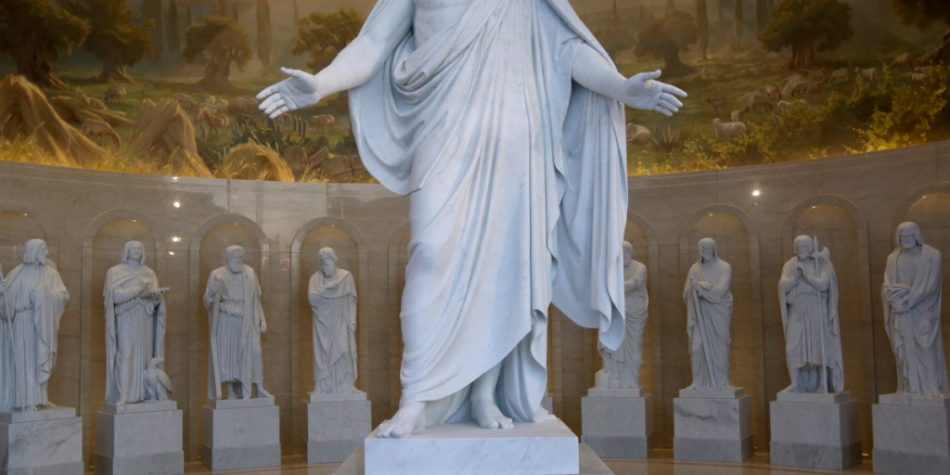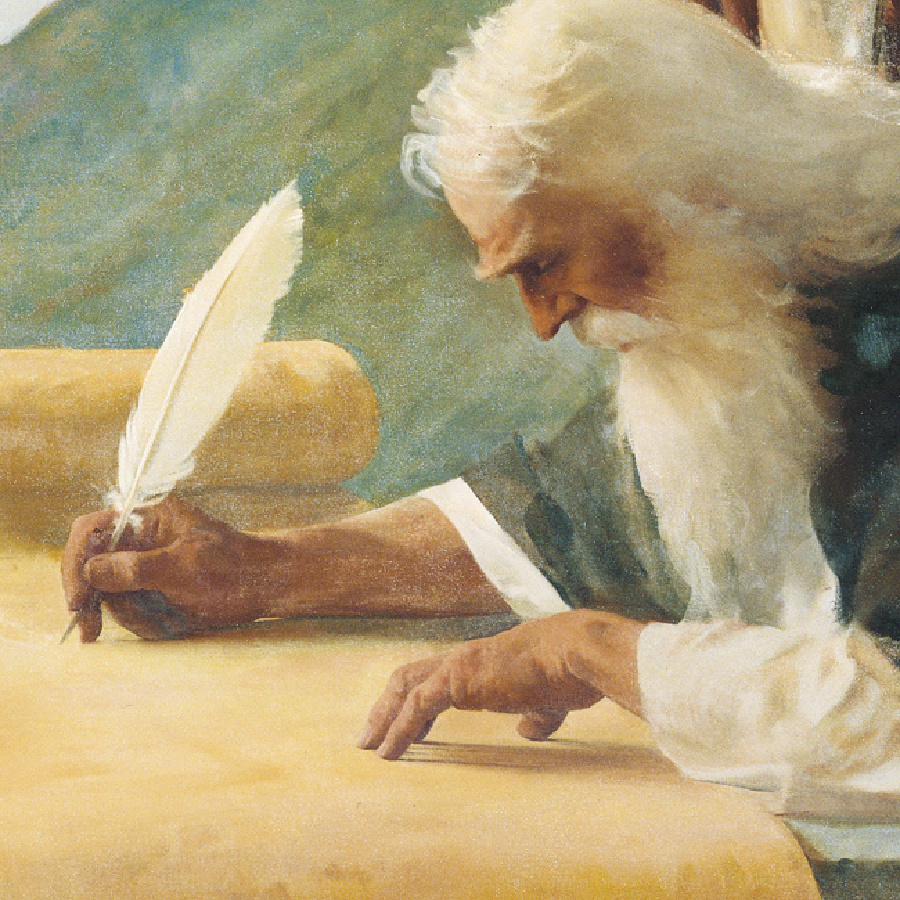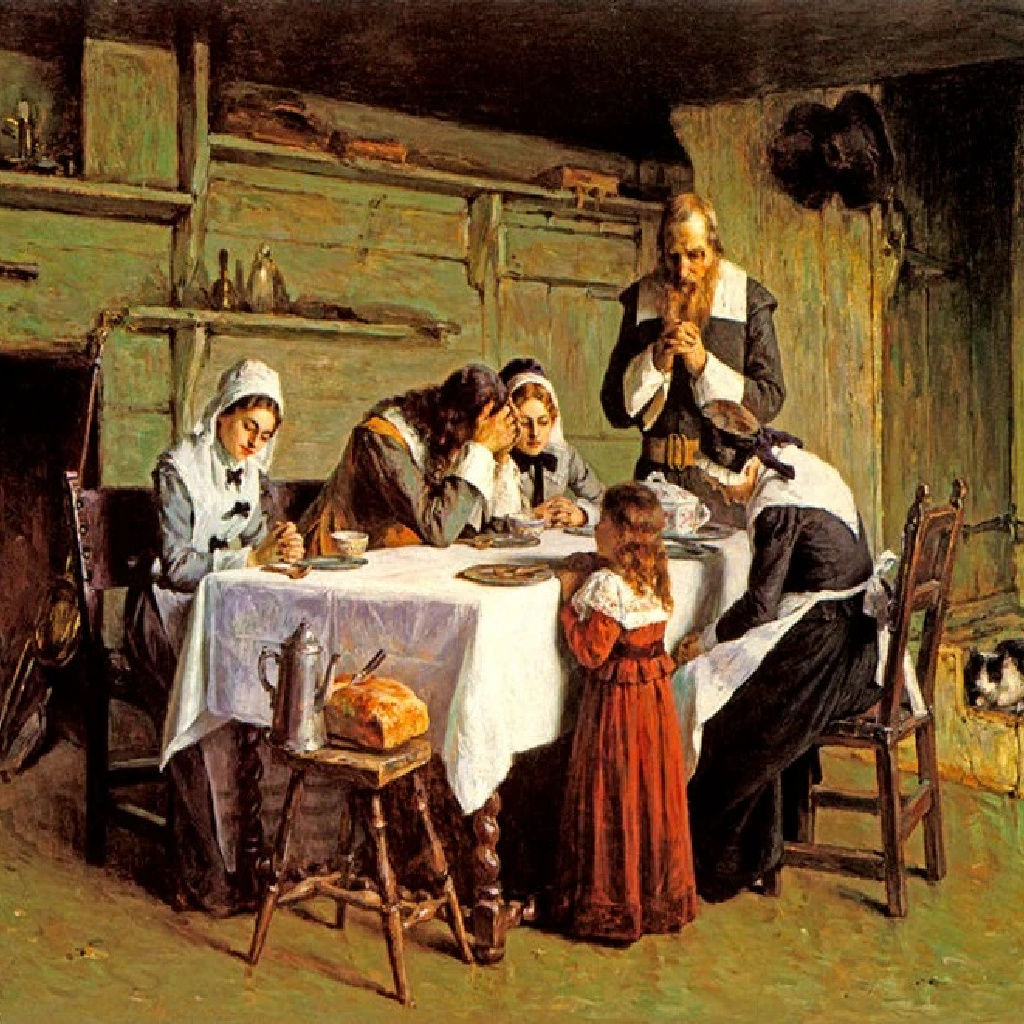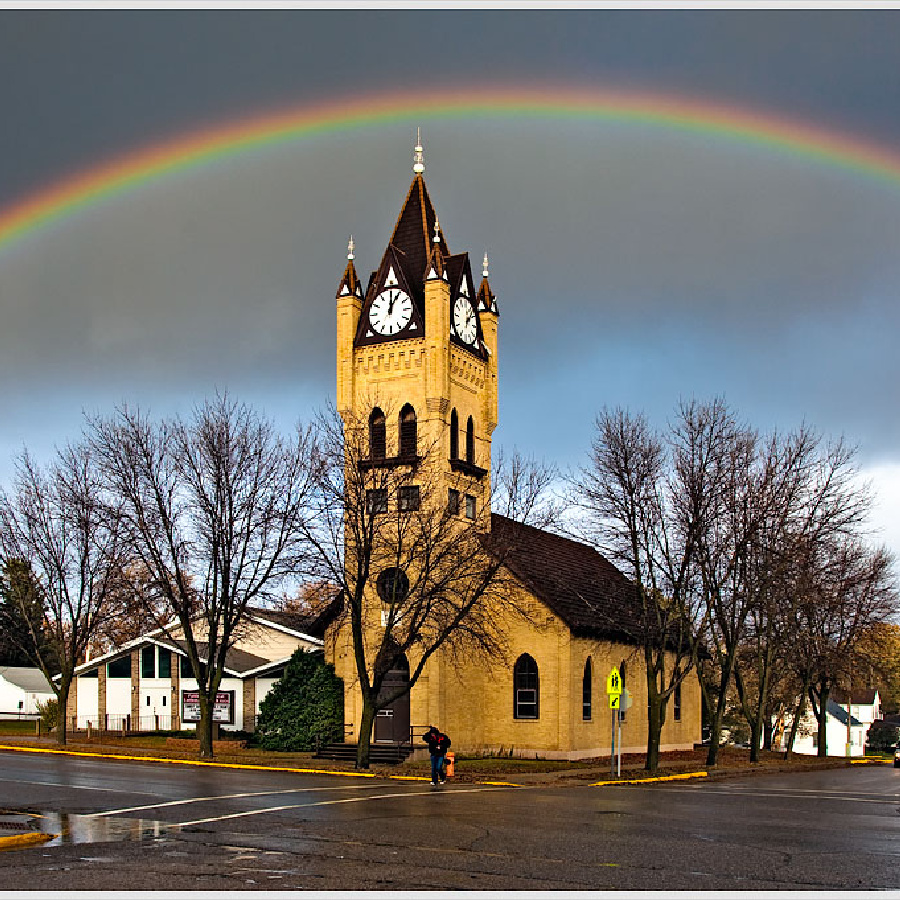At age seventeen I was introduced to The Church of Jesus Christ of Latter-day Saints and baptized—this in the town where I grew up, where Latter-day Saints represented only about seven percent of the population. I knew of the Church in only a cursory way prior—and only by the name “Mormon.” In the fifth grade, I briefly befriended a member of the Church, a mischievous, fun-loving boy. Two things I remembered most about him were his large, strong family, and the name of their religion: “Mormon.”
Or so I thought. I had no idea what that meant; the term seemed obscure and a bit strange—though by all appearances they were as mainstream as anyone.
Later, when I was formally introduced to the Church and—under the influence of the Holy Ghost—taught by missionaries, I was gobsmacked. I had no idea that the so-nicknamed “Mormon Church” was in fact the original Church of Jesus Christ—the one He established anciently—restored anew in our day by Jesus himself. Nor was I aware, consequently, that the “gospel”—the teachings as contained in The Church of Jesus Christ of Latter-day Saints—was no less than God’s plan for the happiness of all His children, all humankind upon the earth.
So, I rejoiced in the autumn of 2018 when President Russell M. Nelson introduced the Church’s name correction and the direction for all, from that point forward, to use the full name of the Church—that the word “Mormon” is not to be used to describe us, and the phrase “Mormonism” is also inappropriate.
And can you imagine, after my own experience, how particularly significant was his statement that “For much of the world, the Lord’s Church is presently disguised as the “Mormon Church”?
Another distinctive thing in President Nelson’s talk that caught my attention was a footnote discussing the ancient Church of Jesus Christ, suggesting a striking parallel to what we see happening today with the modern Church—nicknames applied to its members, often as pejoratives. As he wrote:
Other epithets seem to have occurred in New Testament times. During the Apostle Paul’s trial before Felix, Paul was said to be “a ringleader of the sect of the Nazarenes” (Acts 24:5). Regarding the use of the phrase “of the Nazarenes,” one commentator wrote: “This was the name usually given to Christians by way of contempt. They were so called because Jesus was of Nazareth.” Similarly, another commentator states: “As our Lord was contemptuously called ‘The Nazarene’ (Matt. xxvi. 71), so the Jews designated his disciples ‘Nazarenes.’ They would not admit that they were Christians, i.e. disciples of the Messiah” (Albert Barnes, Notes, Explanatory and Practical, on the Acts of the Apostles [1937], 313, and The Pulpit Commentary: The Acts of the Apostles, ed. H. D. M. Spence and Joseph S. Exell [1884], 2:231).”
The word “Mormons,” invented in the 1830s by bitter detractors, was used in the same way the word “Nazarenes” labeled the members of the ancient church—hurled forth as an epithet, a denigration, a sometime demonization, and consistently employed for the same purposes by their successor critics for over 190 years, even to this day. Meanwhile, the Church, whom God referred to as the “Church of Christ” in initial revelations and then as “The Church of Jesus Christ of Latter-Day Saints,” was officially and unmistakably titled with the name of Christ—even from its beginning, even throughout. This is documented history.
The footnote also calls to mind the odd comfort which some seem to have in referring to members of the Church by any other name than the authorized one that includes the name of deity—particularly the Son of God; and similar comfort with pejoratively used nicknames.
It has been fascinating to observe the reaction of those both in and out of the Church to this major adjustment—mostly positive, some negative; and the peculiar reluctance of some to willingly adapt. For focus here I’ll divide the response of those critical of the name correction into three groups: First, a minority of people external to our faith who customarily express loud criticism of the Church and take hard shots at it on a regular basis; and second, a similar minority internally who do the same—some to a lesser degree. A third group would be all those who expressed relatively mild, sincere concerns. The first two groups openly resisted the change, and it is remarkable how similar are their arguments.
A closer look at each is helpful for clarity. Situated on the extreme end of both of these first two groups are those who, for inexplicable reasons, seem obsessed with habitually criticizing, pounding, and denigrating the restored Church of Jesus Christ—its leaders, history, practices, culture, and active members, even engaging in mockery and religious bigotry. They are found on websites, blogs, podcasts, YouTube, Instagram, TikTok, and other social media channels, hurling ridicule and castigations—in some cases for profit. They dress up videos with dark memes and sinister music. They throw in misleading catchlines as clickbait for the ignorant and unwary. They create juvenile jump scares casting doubt on the Church and its history, portraying everything related to the Church in the worst possible light.
Some—with the same objectives—use tamer approaches. They present dubious arguments under soft voices of seeming thoughtfulness, with favorite-aunt/uncle-like personas. They portray images of unbiased, arms-length, caring commentators—this while engaged in Oprah-like, exhausting, tell-all “interviews” with the disgruntled and disaffected. They trot out supposed historical and scientific “authorities” who carry with them their obvious agendas and veiled angst against the Church—always with preconceived negative assumptions about its divine authenticity, always leading to predictably false conclusions. Many assume credibility by citing their previous or current membership in the Church; some tout their academic credentials. Yet these “hosts,” united with their “guests,” offer little substance, only variations-on-a-theme: carping criticism of the Church.
All these, day after day, pummel away—in some respects like bullies in a schoolyard.
What is one of the singular characteristics of the everyday campus bully? He won’t use your name. He calls you by a pejorative nickname, to depersonalize, diminish and marginalize you, and to seemingly justify his abuse—to signal to all that, given who he says you are, you deserve it.
And isn’t it revealing that the same antagonist never wants to let go of those labels?
And now consider the effect of those labels becoming increasingly obsolete …
Deep detractors, who once held a full grip on this heavy bashing tool—the words “Mormonism” and “Mormon”—are incredulous today finding it suddenly pulled out of their hands. Now you see them flailing semi-desperate to re-grasp it or frenetically reaching for other clubs, and immediately finding those weapons less useful, less effective, and—for those deliberately ignoring the name correction—finding themselves, rhetorically speaking, sidelined—hopelessly out of context. It’s as if they must have those “m” words, those labels, to keep the gig going. And perhaps, they believe, for relevance?
Those inside the faith who on a milder basis critique or criticize the Church are found in the same forms of media, and some in the press. As practicing members, many engage in reasoned discussion and commentary about cultural or social issues within the faith—much of it positive. They run the gamut from benign observers to more vigorous commentators with larger audiences; a number of these, too, exhibited skepticism and even some resistance to the name correction.
Yet when examining in-depth the arguments made against the name adjustment or its feasibility—by any of these groups—one discovers that not only are they basically the same but contain much of the same shaky reasoning.
1) “Using the full name is not practical; the older, shorter references were so handy.” (“Mormon” and “Mormonism” were convenient little words for all of us, weren’t they?) Yet to date, friendly or neutral writers and commentators seem to have little problem adjusting to the longer, authentic name. For journalists, the common, long-standing practice when handling lengthier proper names in a news story or essay is to simply cite the longer name first—once—and then shorter, acceptable, secondary names thereafter. And when we think of the meaning of “acceptable” we also, in all fairness, assume this means acceptable to the organization or church of mention. For this purpose, the Church sincerely yet specifically asks that the alternatives “Latter-day Saints” or “the Church” be used. What is one of the singular characteristics of the everyday campus bully? He won’t use your name.
2) Some writers take issue with the phrase “the Church” saying it implies the only church or the “one true church”—and that ‘it is not their job to promote the truth claims of any faith.’ Yet witness how the media typically covers the Catholic Church. In-depth articles include repeated references such as “the church” or “within the church” etc.—but by doing so journalists are hardly accused of advocating or adjudicating faith claims of one church over another.
Some quibble with using the shorter title “the Church of Jesus Christ” for the same reason—and also, for some, because they think the reference fails to distinguish us as a church, given that hundreds of churches around the world use the name of Christ in their titles. Yet if the full, distinctive name is first cited, this is clearly a moot point, especially given that it is only recommended as one choice among appropriate secondary references.
3) Some say, “The previous, more familiar terms are what our readers (or listeners) already know. Our job is to serve them.” Yet is it not for readers to know that The Church of Jesus Christ of Latter-day Saints is the actual name of this Church? Should the public audience consistently be given substitute references, names not currently authorized by the church of note? And references that not only can potentially confuse the audience, but also mislabel an entire global church and its individual members, and may well invite unwary, unintentional disrespect? Could it be that, by so doing, many readers are in fact misled?
Al Tompkins, who teaches both journalism and ethics as Senior Faculty at the Poynter Institute—a globally-renowned school for journalism—commented on the Church’s name correction and its specific, related guidance, advising writers: “You may say, ‘Wait, who are you to tell me what to call it?’ I’m only telling you to call it what it is, what the proper noun of it is. Who am I (as a journalist)? I’m here to identify you. If it’s your name, it’s your name … this is an issue of accuracy, an issue of clarity, and in some ways an issue of respect.”
In a society insistent on the absolute necessity of calling individuals by their preferred pronoun (even if those preferences shift), surely the same courtesy can be given to an entire church.
4) Another claim: “The Presidents of the Church contradict each other on this issue, particularly President Gordon B. Hinckley and the current prophet, President Nelson.” It is evident from President Hinckley’s writings and speeches that he seriously reflected on this matter over the years—with a variety of related thoughts. While exhibiting an expansive, media-friendly outreach, he clearly sought for the Church to be known throughout the world by the full name that the Lord himself gave it (see Doctrine and Covenants 115:4). In an interview with Suzanne Evens of BBC Radio 5 in the fall of 1996, he personally declared: “We are Christians. No church in the world speaks up with a stronger witness of the divinity of the Lord Jesus Christ as the Son of God and the Redeemer of the world than does this Church, which carries His name—The Church of Jesus Christ of Latter-day Saints.” (italics added).
The fact that Latter-day Saints believe the Lord, for His own reasons, moved inspirationally upon His current prophet—President Nelson—to this degree on this issue at this time does not put our leaders in contradiction with each other. After all, Latter-day Saints believe in living prophets for a living church.
My sense is that in the past when the Church embraced the nickname “Mormon” (never officially or completely—even the “Meet the Mormons” film and many “I’m a Mormon” videos either mentioned or displayed the full name of the Church), one worthy purpose was to help give the old term an improved connotation.
By design, so many who have insisted upon the negative, ubiquitous, substitute usage have attempted to cloud the real name and clear focus of the Church of Jesus Christ, and, to a degree, consequently clouded His name—as similar detractors attempt today. Subsequent increasing tolerance for, familiarity with, and usage of these and related terms (though well-intentioned), nonetheless still left the real name obscured—acting somewhat like a filter.
“Mormonism” is out. Another bold, specific, inescapable aspect of the announcement, with all the earmarks of a shoutout to historians (as well as other authors, writers, and speakers), was the declaration of the First Presidency that the word “Mormonism,” previously put to use to describe the “doctrine, culture and lifestyle unique to The Church of Jesus Christ of Latter-day Saints” is not appropriate and “should not be used.”
And let us not forget: President Nelson also unflinchingly declared that all this direction, and these corrections, are a revelation from the Lord—and “His will.”
Many of those who expressed milder, understandable concerns are primarily people who felt sincere personal, cultural, identifying affinity with the previous nicknames used for so many years. Among these are members of the Church who always viewed themselves as disciples and followers of Christ. Perhaps we all can relate to the feelings of Andrew Marshall of Silver Spring, MD, who, after the implementation of this change, said: “When I was baptized, I believe I really did take the name of Jesus upon me. In some ways, my identity was subsumed in his. As I’ve thought more about being a member of The Church of Jesus Christ of Latter-day Saints, I felt that a bit more deeply.”
As one studies President Nelson’s pivotal October 2018 Conference talk and subsequent teachings, companion sermons, writings, and interviews of several other apostles over three and one-half years, as well as the initial announcement, accompanying style guide, and other reference material available on the Church’s website, it becomes clear that this change is not a mere plea for “emphasis.” Rather, it is a pointed, deep, permanent, macro change—well thought out, and, to this day, thoroughly and persistently executed.
Though initially, some said, perhaps reflexively, “It won’t last” or “We’ve seen this before,” yet it’s hard now not to observe the many permanent, significant alterations and additions. The vital domain name change to churchofjesuschrist.com/org, the Christus image in the new Church symbol, the newly crowned, “Tabernacle Choir at Temple Square,” and, as Elder Neal L. Anderson of the Quorum of the Twelve Apostles said, “more than one thousand products that had the name “Mormon” or “LDS” attached to them … renamed,” evidence only the beginning of efforts too lengthy to list.
The amount of work required is staggering. As President Nelson said: “It’s a challenge to undo tradition of more than 100 years.” Think of the extraordinary efforts on the Internet and within vast knowledge databases—altering innumerable lines of code and countless titles and naming conventions, this in a church that has long embraced advancing technology. This mission continues as an ongoing work in progress.
Now, more good news: the continuing reports of the courteous reaction among much of the press—along with many fellow Christians and our friends in other faiths. Though some recent national Church-related stories contained the previous names in their headlines, nevertheless the clear, overall trend is one of adjustment and respect.
For example, a review of world press coverage over the first six months following the announcement revealed a respectful approach to both the topic itself and the Church’s view concerning it. As Bob Smietana of Religion News Service reported: “Outsiders, researchers, and reporters respected the religion’s right to self-identify, and many strived to follow its preferred style guide.”
Richard J. Mouw, president emeritus of the Fuller Theological Seminary and a leading Evangelical writer and speaker, apparently reacting to a few early naysayers, remarked: “It’s hard to get worked up over this. Many churches ‘own’ labels expressing identities the rest of us also claim.” The Reverend Dr. Andrew Teal, Oxford chaplain and Christian religious scholar, said of the correction: “Initially, I thought, why use all these words when the singular Mormon might do? But now I see just how sloppy that would be, and the wisdom of that revelation to President Nelson.” Dr. Teal sees it as an emphasis on “eternal identity, that of belonging to the only name under Heaven conveying health and salvation.“
The needle continues to move: an in-depth study of news reports covering the first 24 months after the announcement found that those writing neutral or favorable articles about the Church—and there were many—tended to use the authorized references, and those authoring critical or unfavorable stories were inclined to resurrect the old terms. As time moves forward, the shift is more and more visible. One very recent scholarly essay on a Church history topic, written by a respected historian who initially resisted the change, repeated the term “Latter-day Saints” throughout most of his references—instead of the oft-used previous nicknames. For many members, it now feels strange that we ever called ourselves “Mormon,” especially given the new feel and focus of our accurate identity. We experience this as a welcome, new and permanent reality.
And could it be, regarding social, information, and print media—including books and television—that we will soon arrive at the point (if we are not already there) where if one sees a new title or headline or content that includes the words “Mormon” and/or “Mormonism,” they will know immediately that criticism is coming—and likely from a source less-than-complimentary toward The Church of Jesus Christ of Latter-day Saints? Where will this short-hand heuristic leave these authors or publications in the minds of their readers or listeners?
Among the vast majority of active Latter-day Saints, these name clarification efforts, and emphasis on the Savior Jesus Christ—always so central to our faith—were met with joy and enthusiasm. Corrine Stokoe, Co-Director of Mint Arrow Messages Podcast summed up the feelings of many: “It seems like people right now are a little bit more open to making sure that they are correct in the way that they classify different groups. I feel like there’s more sensitivity toward that and openness to making sure that things are done properly. We hope you’ll understand why this is a really big deal to us.” And Steve Evans said, “I think that it really has caused me to focus a little bit more on Christ as the center point of my belief.”
At the end of the day, we all inherently know that any group or institution has the right to change or correct their self-identification. In the spirit of kindness and goodwill and friendship which we all seek earnestly in the world, I humbly suggest that it behooves each of us, as fellow travelers here, either of press or public, from scholars to ordinary observers, to forever drop the terms “Mormonism” and “Mormon” and willingly call The Church of Jesus Christ of Latter-day Saints, its members, culture, and teachings—past and present—by their authorized names.

















